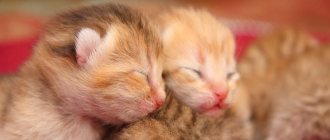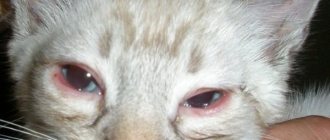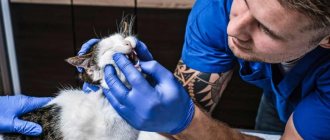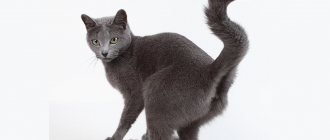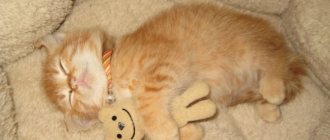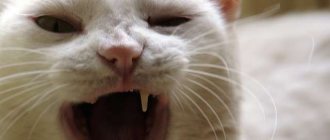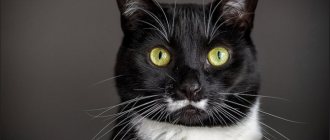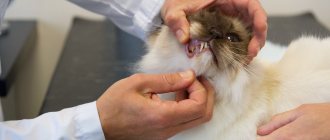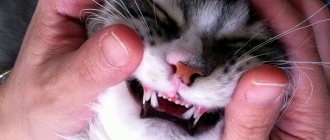Kitten behavior when replacing teeth
You may not notice tooth loss if you don’t look into the mouth, or until a kitten’s fang falls out in front of the owner’s eyes. But the behavior of all kittens changes at this time: they become restless and chew on everything. This is normal because the gums where the permanent teeth erupt are itchy.
It is important not to forget about raising a kitten and to monitor what exactly it chews. Items such as wires, plastic, anything that he can bite off but his stomach will not digest must be removed or else a blockage in the stomach or intestines may occur. There is no need to train an animal to gnaw the hands and feet of its owner. This bad habit becomes ingrained during the change of teeth, and it will not be easy to wean it off. The harmless and almost painless biting of a kitten will later be replaced by the bite of strong and sharp incisors and fangs of an adult cat.
When your pet needs help
The help of a veterinarian is needed in the following cases:
- inflammation or ulceration of the oral mucosa - gingivitis, stomatitis;
- after a baby tooth falls out on the jaw, a non-healing wound forms in its place, sometimes with signs of purulent inflammation, which indicates periodontitis;
- disruption of the growth of a permanent tooth in the vicinity of an unfallen milk tooth; in this case, both a delay in the growth of a permanent tooth and a change in its position in the dentition are possible, while the tooth may begin to injure soft tissues, the formation of a malocclusion and even deformation of the bones of the facial skull with the formation of asymmetry of the muzzle. The formed double row of teeth contributes to the accumulation of plaque and the development of inflammatory diseases in the oral cavity, a complication of which can be osteomyelitis of the jaw bones with the formation of fistulas. It is recommended to remove a baby tooth in a veterinary clinic under anesthesia.
Unlike irritation, with gingivitis the redness and swelling of the mucous membrane are more pronounced; pus, pain, anxiety, depression, refusal to feed may appear
Diet for a kitten
During the period of bone tissue formation, food should contain a sufficient amount of calcium and fluorine. A lack of mineral elements will cause delayed, uneven tooth replacement. Dry food for kittens contains all the necessary mineral supplements and will be useful as crackers for massaging swollen gums. The kitten may refuse to eat because they are sore, but this may not last long. A cat, as a predator by nature, cannot starve for more than 2 days. A small cat will only be able to skip one feeding. If he continues to starve, then you need to contact your veterinarian.
Feeding a cat without teeth
If for some reason your cat is left without teeth, do not despair. In nature, the cat family needs teeth to bite or strangle prey. With their fangs they tear off smaller pieces from large pieces of meat and swallow.
At home, a toothless cat can be provided with soft food. To do this, purchase canned meat and fish purees and pates at the pet store. Soak dry food with water no higher than 30 degrees. Please note: not broth, not milk - but water!
Cats' gums are very sensitive to cold and hot food, so food should be at room temperature. If the cat eats natural food (we don’t really recommend this, and we certainly warn against combining “natural” food with professional food), then it is better to refuse beef and replace it with white chicken or rabbit meat (pork and fish are completely harmful for cats). An older cat should eat more often than usual (three to four times a day), but the portions will be smaller, although the total volume remains the same.
The age of a person can be easily determined by the number of wrinkles and flabby muscles, but the age of cats is revealed by their teeth. In older cats they are worn out and more yellow. But by taking preventive measures and caring for your furry pet with love, you will help keep his teeth for as long as possible.
How kittens teeth change
Why does a kitten's teeth fall out? Kittens are born toothless. After two weeks, their baby teeth begin to grow. Teeth change in cats occurs at 3-5 months of age. At 5 months, a kitten loses its teeth: 26 small and sharp milk teeth are replaced by 30 permanent teeth.
Tooth loss in kittens occurs in stages.:
The fangs begin to fall out from the lower jaw. When a kitten's teeth fall out, small wounds remain in their place. If teeth fall out with blood, then this is not considered a pathology.
The peculiarity of dental replacement in a kitten is that the molar tooth does not grow in the place of the milk tooth, but next to it. The jaw can contain both primary and molar teeth, forming a double row. The milk jugs fall out, the kitten's mouth takes on a normal appearance.
During these months, the kitten may develop an unpleasant odor from the mouth, which disappears by the end of the change of baby teeth. If the teeth have not fallen out before 7 months, they will have to be removed at the veterinary clinic. Reason: preserved milk jugs disrupt the dentition, which can lead to injury to the gums and changes in the bite. Deviation of the roots from the normal dental axis leads to uneven abrasion of tooth enamel when chewing food and tooth decay.
Caring for a kitten during the period of teeth change
The period of changing teeth can really become a test for an inexperienced owner. However, it is necessary to understand that the animal is not sick, does not need to take medications and constant visits from veterinarians. Most often, for a cat, everything happens, if not unnoticed, then at least painlessly.
There is no need to allow the kitten to chew furniture, spoil things, and especially not to bite and scratch you. In the future, this habit could become a really serious problem. Changing teeth is a natural process for an animal; therefore, the initially established rules of behavior must be preserved.
However, the task of every responsible owner is to make this period easier for the animal, take care of proper nutrition, brushing teeth and the availability of special toys.
Special food
A kitten needs proper and complete nutrition . However, despite the abundance of food created specifically for the period of teeth change, the animal may react negatively to a sudden change in food. Therefore, you need to ensure that your pet has the necessary vitamins and supplements in its diet, thanks to which permanent teeth will grow strong.
There are nutritional principles that must be followed when a kitten’s teeth change:
- First of all, you need to avoid overly soft food: kittens can swallow lost teeth along with soft food, which can lead to damage to the esophagus. The food should be large and slightly rough. Regular dry food for kittens is ideal.
Dry food is the best option during teeth change
- Large pieces of meat (beef, turkey, chicken, rabbit) scalded or boiled, cut into small pieces, are also ideal for a kitten.
- You need to include cottage cheese and other fermented milk products that are rich in calcium in your diet.
- The kitten needs calcium and phosphorus; they can be given as supplements to the main diet. At the pet store you can find both drops and small tablets that can be added to food. Such supplements also contain a little analgesic so that the kitten does not experience severe pain.
- A maximum of twice a week, you can give your kitten low-fat boiled sea fish, for example, hake. However, you should not overuse fish, even though it is rich in phosphorus.
- Meat or fish should be given mixed with cereals: oatmeal, buckwheat or rice. It is also useful to add some vegetables, such as carrots, zucchini or pumpkin, both raw and boiled.
- The diet should also include sufficient amounts of vitamins A and D.
- The kitten will try to chew everything, including your things, so it’s worth purchasing special bones. They contain the necessary vitamin supplements, and in fact the kitten gets the opportunity not only to strengthen its teeth, but also the necessary amount of vitamins supplied with saliva.
Bones are an important part of the diet and serve to prevent the kitten from chewing your things.
Veterinarians advise not to mix natural food (meat, fish, vegetables, etc.) and dry food. If you switched your kitten to dry food at an early age, then you should stick to it. The fact is that these types of food are digested differently, and when mixed, the kitten may experience bloating or even colic.
When choosing a feeding method, you should consult a veterinarian: each pet is individual, many may not be suitable for dry or natural food
Vaccination during the period of teeth change
Very often, owners are faced with an important question: is it possible to get vaccinations or other vaccinations while changing teeth? Veterinarians speak out unequivocally - changing teeth is already a serious burden for a kitten. Against the backdrop of fever and pain, getting vaccinated can be dangerous. This not only adversely affects the kitten’s immune system, but also leads to stunted growth of the animal.
Vaccination during the period of teeth change is not recommended.
It is important to follow the vaccination schedule for your pets as prescribed by your doctor. The vaccination schedule is set individually, taking into account the age characteristics of the body and physiological state.
My kitten was scheduled for the first vaccination very late. This was due to the fact that he was found on the street and many tests had to be done to assess his health. The time for his vaccination was due to change his teeth, so it had to be postponed for a while (until the temperature passed and slight inflammation of the gums subsided).
Teeth cleaning
Many owners ignore brushing their teeth. However, constant oral care will help keep your animal's teeth strong. It is necessary to accustom your cat to brushing its teeth from the early months of life so that in the future it will adequately perceive this procedure. If the cat refuses to accept traditional brushing with a toothbrush or powder, pet stores sell special gels for disinfecting the oral cavity. You can combine them with special foods and vitamins that include coarse fibers. It is recommended to brush your teeth once every three to four weeks.
Brushing your teeth is an important procedure that your kitten needs to be accustomed to.
During the change of teeth, kittens' gums can become inflamed, so you need to purchase a gel that also contains an anesthetic and anti-inflammatory, which can greatly alleviate your pet's condition.
Oral hygiene
A kitten should be taught to care for its teeth as early as possible so that the animal is not afraid of this procedure. When changing teeth, mouth sanitation is especially necessary to prevent the formation of plaque and tartar. In places where there is loose contact between the tooth and gum, which occurs when baby teeth become loose, food residues get stuck, plaque and then tartar form. At the site where the tooth fell out, wounds remain that require treatment, especially if they are bleeding. Until complete healing, this is the gateway for infection into the kitten’s body.
Source
Causes of loss of fangs
Loss of teeth, including fangs, can have several causes:
- physiological – natural change of baby teeth to permanent ones;
- age-related – tooth loss caused by degenerative processes in the aging body;
- pathological – tooth loss occurs as a result of pathology of the tooth crown, gums or trauma.
Natural change of teeth is a temporary process. In the wild, the female helps feed during this period.
Physiological change of teeth
Kittens are born toothless and feed on their mother's milk until their first teeth appear. First, the incisors erupt, and this happens at the age of 1-2 weeks. Then after 3-4 weeks the canines appear and after 6-8 weeks the premolar teeth finish erupting. Babies have no molars. By 2 months, the kitten should have 26 baby teeth. They are whiter and thinner than permanent ones.
The replacement of baby teeth with permanent ones begins at the age of 3.5-5.5 months. The procedure is the same as for teething:
- 3.5-5.5 months. – incisors;
- 5.5-6.5 months. – fangs;
- 4.0-5.0 months. – pre-radical.
Molars appear in babies at the age of 5-6 months. By 7 months, the physiological change of teeth should be completely completed. But in some cases it drags on for up to 9 months.
In females, the replacement of milk teeth begins later than in males.
An adult cat's complete dental formula is:
- 12 incisors - 6 pieces each on the lower and upper jaws;
- 4 fangs;
- 10 premolars (premolars);
- 4 molars.
There are a total of 30 permanent teeth in a cat's mouth. Signs of tooth change are:
- hypersalivation - excessive salivation;
- the desire to chew and gnaw inedible objects;
- decreased appetite;
- mood changes – irritability, aggressiveness, increased excitability;
- decreased physical activity due to malnutrition.
You need to help your baby get rid of a loose baby tooth only if it interferes with the eruption of a permanent one. Sometimes instead of 4 fangs there are 8 – the milk ones have not yet fallen out, but the permanent ones have already appeared. This happens due to the fact that fangs are formed in separate follicles. Normally, the kitten will get rid of the tooth that is causing discomfort on its own, but the help of a veterinarian may be required.
Age-related canine loss
With age, degenerative processes occur in the animal’s body:
- mineral metabolism is disrupted - teeth become less durable, they wear out and even break. The longest ones in the jaw, the canines, are especially affected;
- Collagen synthesis decreases - teeth begin to loosen due to weakening of retaining fibers and loosening of gum tissue;
- Immunity decreases, which increases the risk of infections and the development of dental pathologies.
Signs of wear on dental crowns (the part of the tooth that protrudes above the gum) can be seen in cats aged 3-5 years. The animal's teeth become dull and darker due to deposits of tartar and soft plaque.
Cats older than 5-6 years may already be missing some teeth. To extend the life of the dental system of a domestic predator, you need to monitor oral hygiene from the first months of life.
Even with the complete loss of fangs and significant thinning of the dentition, a domestic cat will not suffer from hunger. Companies involved in the production of pet food produce a number of special lines of food for cats older than 7-12 years.
Pathological tooth loss
Dental problems can lead to the loss of canines and other teeth, even in a young animal. Caries is a fairly rare pathology in cats, which is due to the structure of the predator’s dental crown. Fangs are least often affected by caries, since they do not have grooves and depressions on their surface in which food can accumulate. But other pathologies can lead to caries:
- traumatic chipping of fangs as a result of gnawing hard objects;
- trauma to the gums by sharp fish and poultry bones with subsequent penetration of infection into the wounds;
- metabolic disorders leading to thinning of the enamel;
- lack of minerals and vitamins in the diet necessary for the mineralization of teeth;
- deposits of tartar, which is a nutrient substrate for pathogens.
In addition to caries, a cat can lose its fangs as a result of:
- periodontitis;
- gingivitis;
- odontogenic osteomyelitis;
- tartar;
- pulpitis.
Pets suffer from the same dental problems as their owners. A cat can lose its fangs from mechanical damage or injury - breaking them in a fight, falling from a height, or a direct blow to the face.
Today there are not many veterinary clinics that offer a full range of services for treating dental diseases of pets. But in large cities, a furry pet can have an implant installed in place of a lost canine or premolar. The question is the cost of this service. The high cost significantly reduces the demand for dental prosthetics in cats.
Milk teeth and their replacement
In most cases, kittens are born without teeth. Milk teeth erupt at 7-14 days of age. When a kitten reaches 2 months of age, it should have 26 teeth. Baby teeth begin to fall out when the kitten is about 3-4 months old and this process lasts about 3-4 months. If your kitten is 7 months or younger, then teeth may fall out and this is normal. Monitor your pet's overall health, as well as the condition of his gums and teeth, count how many teeth have fallen out and which ones.
Advice from a veterinarian-dentist
Removal of any fixed teeth, no matter whether they are temporary or permanent, must be carried out using anesthesia and analgesia. Dental pain is a moderate pain and proper analgesia is required for every patient.
To the question, is it possible to anoint the gums with something anesthetic or give them local anesthesia like in humans, I will answer right away - no, it is not possible.
Local analgesic gels will anesthetize the mucous membrane of the gums and tongue and increase salivation in the dog, which can lead to vomiting and aspiration of vomit into the trachea, and in cats their use is even more dangerous, since such gels can lead to laryngospasm and respiratory arrest. Unfortunately, a local injection into the gum cannot be carried out without the use of sedatives that induce sleep. I have a hard time imagining a cat or dog whose gum someone tries to stick a needle into. But even if this happened, after such an injection no patient will ever be allowed near him again.
Gil Veronika Yurievna, veterinarian, surgeon, dentist
https://gilvet.ru/stati/molochnye-zuby-u-sobak-i-koshek/
Captive temporary teeth, which are already being replaced by permanent teeth, are called persistent and must be removed at the first visible changes in the bite.
It is impossible to leave persistent teeth, because the dentition of an adult dog is designed for 42 teeth, and for a cat 30, and if there are more teeth, periodontitis will begin... The age for removing baby teeth is not a specific number. Everything happens individually for each animal, and to say, for example, that the optimal age is 8 months is wrong. Each animal has a different age for extraction; some require removal of persistent teeth as early as 5 months of age.
Gil Veronika Yurievna, veterinarian, surgeon
https://gilvet.ru/stati/molochnye-zuby-u-sobak-i-koshek/
In some puppies and kittens, the change of teeth occurs with an increase in body temperature and a decrease in appetite, sometimes even with a refusal to feed. In such situations, it is better to consult a doctor for help.
In cats, during the change of teeth, a very strong odor from the oral cavity is not a strong pathology, and if you see double rows of teeth (both permanent and temporary), know that this occurs normally. But if you notice that your permanent teeth are starting to grow and interfere with each other, you need to consult a specialist.
Gil Veronika Yurievna, veterinarian, surgeon, dentist
https://gilvet.ru/stati/molochnye-zuby-u-sobak-i-koshek/
If they removed temporary teeth and broke the crown, leaving the root in the gum with the words “it will resolve on its own,” I answer - no, it will not resolve.
Why should the root of a tooth dissolve because you have broken the crown? It will remain in the gums as a foreign body and at a certain time can cause the process of periodontitis of adjacent teeth or osteomyelitis of the jaw bones...
With any injury to the crown of a temporary canine, traumatic pulpitis occurs, and as a result, periodontitis develops with an abscess on the jaw, inside of which there is a rudiment of a permanent canine. Trauma, pain, inflammation and the possible loss of not only a temporary, but also a permanent canine - this is the price to pay for an incompetent attempt at self-medication.
In case of traumatic pulpitis of a temporary canine, the tooth must be immediately extracted (removed).
Gil Veronika Yurievna, veterinarian, surgeon, dentist
https://gilvet.ru/stati/molochnye-zuby-u-sobak-i-koshek/
If the temporary tooth is mobile and “almost transparent to the light”, there is no need to remove it at all - let the animal chew on something in which to sink the teeth (for example, a not very hard “chew” or a large treat), and, believe me, the tooth will fall out on its own .
Gil Veronika Yurievna, veterinarian, surgeon, dentist
gilvet.ru/stati/molochnye-zuby-u-sobak-i-koshek/
Video: cat dental care
Other causes of tooth loss
With proper care, a balanced diet and the absence of external traumatic factors, cats retain their teeth until old age.
If a baby tooth falls out in a cat that is under 1 year old, then this is normal. An alarming sign for the owner if a tooth falls out in a cat whose age is more than 1 year. By this time, the replacement of milk teeth with permanent ones should be completed. If teeth continue or suddenly begin to fall out, then this is a sign of pathology.
In cats, a lost tooth may be a signal of one of the causes:
- oral injuries;
- decreased immune system defenses;
- violation of microflora in the oral cavity;
- lack of vitamins and minerals;
- metabolic disease;
- tartar;
- taking hormonal drugs or antibiotics;
- diseases of the gums and teeth (pulpitis, gingivitis, caries, periodontitis, stomatitis);
- malocclusion;
- viral and infectious diseases;
- diseases of the gastrointestinal tract;
- oncological diseases.
Some reasons why teeth may fall out are quite obvious to owners and do not require seeing a doctor. If a cat's fang has fallen out, it is likely due to injury. Usually, it is enough to simply treat the wound and ensure that the injury site heals. But sometimes it is quite difficult to determine why a cat’s teeth are falling out. In this case, it is necessary to monitor the pet, track any changes in behavior and health. Such information can help the veterinarian select appropriate examination methods and make the correct diagnosis.
Possible complications during the period of teeth change
Changing teeth is a natural process that can occur without problems for the animal. However, during the period of active growth of molars, you should inspect the animal’s mouth at least once every few days. It is important to consider that reddish and slightly inflamed gums are normal. However, in some cases complications arise. A caring owner should notice the problem in time and be sure to contact a veterinarian.
The most common complications that are visible to the naked eye:
- Suppuration of the wound at the site of the lost tooth.
- The animal shows anxiety, meows pitifully, and may experience severe lethargy.
- The kitten refuses to eat for two days.
- Very severe inflammation of the gums.
- Wounds appear from a missing milk tooth, in the place of which a permanent tooth has already grown.
- Some of the baby teeth have not fallen out, although the permanent ones have already grown in and the time for changing teeth has already passed.
In these cases, you should take the kitten to the clinic or call a doctor at home.
Don't hesitate to contact your veterinarian, even if your pet doesn't show signs of restlessness, lethargy, etc. A healthy animal also needs control, so veterinarians are very loyal to owners who bring healthy animals for examination and ask to monitor the process of changing teeth.
Gum inflammation
Inflammation of the gums is one of the most common complications during the period of teeth change. A little inflammation is normal, but in some cases it lingers and the gums become red.
Inflamed gums become swollen and red
Signs of gum inflammation:
- the animal is restless;
- refuses to eat due to painful sensations;
- tries to chew more;
- rubs its muzzle against everything in an attempt to relieve pain;
- profuse salivation occurs;
- swelling and intense redness are noticeable.
Of course, it is better to have a veterinarian do the diagnosis and treatment, but gum inflammation may go away when the kitten is switched to softer food.
What symptoms accompany tooth loss?
A cat's tooth can fall out for various reasons. If this happened due to injury, there may not be specific symptoms. However, if a pet who has lost a tooth experiences changes in behavior and other signs, this should be a cause for concern and seeking medical help.
Symptoms that may accompany tooth loss:
- copious amounts of saliva;
- swollen gums;
- redness of the gums;
- bleeding from the gums;
- the presence of ulcers in the oral cavity;
- presence of pus in saliva;
- increased excitability, aggression, irritability;
- refusal of food and drink;
- having difficulty chewing;
- bad breath.
If your cat has lost a tooth, you should not ignore it. This may be a sign of a serious pathology. The spread of infection in the oral cavity can cause serious diseases of the internal organs.
Consequences of tooth extraction
Complications are possible after the removal procedure. You will immediately understand that your animal is experiencing discomfort or pain. The cat will refuse to eat, will worry, meow loudly, and rush around the house.
Common complications include the following:
Alveolitis. Bad breath, refusal to eat, quickly swallowing pieces without chewing are signs of gum inflammation. The treatment is quick and painless. The doctor cleans the inflamed hole and applies a bandage with disinfecting ointment.
Bleeding. If there is excessive bleeding, the hole must be sutured.
Jaw fracture. It can only be detected by injury during removal, if the doctor applied too much physical force to the jaw.
Unfortunately, tooth extraction in cats is quite common, since many animal owners, out of ignorance, do not care for the cat’s oral cavity. Therefore, they come to the clinic with advanced cases and the teeth are removed.
Tooth extraction in cats occurs only when treatment no longer helps. It must be remembered that many dental diseases are asymptomatic, so it is necessary to periodically examine the oral cavity so that you do not have to resort to such a procedure.
Let's look at the cases in which teeth are removed.
- Incorrect placement of milk or molars, which interferes with the normal functioning of the animal - the soft tissues of the oral cavity are damaged.
- In severe cases, where conventional treatment has not yielded results - feline lymphoplasmacytic stomatitis.
- Teeth that are close to each other is called crowding. In this case, there is a risk of getting sick because Food will accumulate between the teeth and this will lead to an inflammatory process.
- Internal root resorption
- External root resorption
- Milk teeth that did not fall out on time on their own, but the molars have already begun to grow and the milk teeth interfere with the growth of new teeth.
- Teeth located under the gum mucosa are also subject to removal. They have not erupted, but a cyst may form under the gum and this will harm the adjacent teeth.
- The indication for tooth extraction is periodontal disease.
- Odontoclastic resorptive lesion of teeth – classes 2,3,4
Tooth extraction is carried out only under anesthesia. After tooth extraction, your pet must have the wound sutured, otherwise there is a risk of infection, and the wound will take a long time to heal.
How to help a cat
What to do if a cat’s teeth fall out is a rather complex question that cannot be answered unequivocally. Depending on the reasons, the method to solve the problem will be different.
First of all, it is necessary to observe the animal whose tooth has fallen out and note (preferably write down) any changes in its habitual behavior. This could be a change in activity, a change in character, or a refusal to eat. And also more obvious signs - bad breath, the presence of bloody or purulent discharge from the oral cavity. All this data is necessary for the veterinarian to determine what examinations are needed for an animal whose tooth has fallen out. This information will also help in making a diagnosis.
Depending on why the tooth fell out, the following solutions to the problem may be suggested::
- choosing the right diet;
- taking medications to strengthen the immune system and teeth;
- treatment of gum diseases;
- removal of tartar;
- treatment of the underlying disease.
Most often, a cat's teeth begin to loosen and fall out due to tartar. The veterinarian will suggest scaling. This procedure is usually performed under general anesthesia. However, it is best to carry it out under so-called “premedication”. These drugs cause less harm to the pet's health. During the procedure, the animal will be conscious (which will be stressful for it), but will not be able to resist. After this, the cat needs the same care as after general anesthesia for 24 hours.
Treatment
Treatment is prescribed by a doctor on an individual basis in each case. It depends on the health status, age of the pet and the cause of the tooth loss.
It is impossible to restore a lost tooth in a cat; the main thing for a veterinarian is to prevent subsequent losses.
The specialist prescribes medications that strengthen teeth and the immune system, and adjusts the pet’s diet. Removes the main cause of disease – tartar. Conducts treatment that strengthens the gums and reduces their bleeding; determines and prescribes treatment for the underlying disease that led to tooth loss.
Read about the main dental diseases: Dental treatment for cats
Self-treatment can cause irreparable harm to the animal. Only a specialist prescribes medications and sets the required dosage.
Prevention of tooth loss
It is easier to prevent any disease than to treat it. Tooth loss in cats can be prevented if you pay due attention to the health of your pets. In nature, the animal consumes all the products it needs and can clean its teeth by chewing grass and branches. Living in an apartment, the cat is deprived of this, and the owners must provide him with all the necessary conditions.
Diseases of gums and teeth, as well as their loss, can be prevented if the following conditions are met::
- A balanced diet that includes all essential vitamins, minerals and other nutrients.
- Oral hygiene.
- Regular examination by a veterinarian.
- Timely treatment of gum diseases.
When visiting the veterinarian for the first time with your pet, you should find out detailed information regarding the above points. The doctor will give detailed advice on caring for your cat and tell you what needs to be done to avoid dental and gum diseases.
To clean your cat's teeth, use a special toothbrush or a baby toothbrush. A special brush for cleaning pets' teeth usually has 2 brushes at the ends - a large one for dogs and a small one for cats. You should not use your regular toothpaste. Its components may harm your pet's health. Special toothpastes for pets are produced. In retail chains you can most often find toothpastes for dogs. They are also suitable for cats.
To brush your cat's teeth, you need to pick him up in a non-excited state. It is advisable that he be sleepy. You should not interrupt your cat's play to carry out the procedure. Apply a small amount of paste to the brush and gently scrub your teeth and gums. Be prepared for a lot of salivation and resistance from the cat.
If your cat has not lost a tooth, but has inflamed gums, you should also consult a veterinarian about your actions. The most common recommendation is to treat gums with dental gels. These medications are sold in regular pharmacies and are intended for people, but are also suitable for animals. Apply a little gel to your finger and massage your gums. The cat will salivate profusely. After this procedure, he may become a little lethargic and sleepy.
Source
How to prevent diseases
The Murkoshi team draws your attention to the fact that regular high-quality dental care for your cat is the prevention of the formation of tartar, which provokes the occurrence of more serious diseases.
To clean plaque, use special toothbrushes and pastes. Products used by humans cannot be used to clean a cat's teeth. A dose of some components of the “human” paste will negatively affect the health of the pet. And the rough bristles of the brush will damage the delicate gum tissue.
Read more about how to brush your teeth properly: How to brush your cat's teeth
To prevent your cat’s teeth from falling out, the diet must be balanced and contain sufficient vitamins and minerals. It is advisable to choose dry food of super premium and holistic classes. At the Murkosha shelter, cats receive exactly this kind of food. You can also give pate or wet food (similar grade) as a treat.
It is necessary to visit a veterinary clinic twice a year to identify the disease at an early stage. This will also allow your pet to be treated for parasites and vaccinated in a timely manner.
More details about the need for vaccinations: Annual visit to the veterinarian - what is included and why it is needed
Features of the cat's dental system
The cat is a predator that hunts small rodents, kills them and eats their flesh. Due to this form of nutrition, the dental system of a predator has a special structure. The incisors are practically not involved in hunting and chewing food and therefore are small in size. Cats use them to catch fleas and bite dirt out of their fur coats.
The most significant in size are the fangs. These long, sharp teeth are essential for holding onto caught prey. They are slightly curved inside the oral cavity and are also used for protection. The loss of fangs is tantamount to the loss of weapons. A predator cannot kill its prey and tear it apart. If the fangs are lost, the animal will have to be content with carrion.
Molars and premolars are saw-shaped. Their sharp cutting edges help to cut meat and cut it off the bones. Due to the lever action of the jaw joints, the cheek teeth act like scissors. The upper part of the crown of a cat's cheek tooth is sharper than that of some members of the canine family.
The cat does not chew its food because it is not necessary. Her saliva does not contain digestive enzymes. The enzymes needed to digest protein foods could also dissolve oral tissue. Therefore, predators simply swallow large pieces.
Natural selection is very rational and cruel, therefore, in the wild, a predator that has lost the ability to feed and defend itself dies.
Is missing teeth dangerous for cats?
It is quite natural that not all cat owners take proper care of their pet, and there are cases when the teeth become so unusable that it is easier to remove them than to treat them. This proposal leaves many cat lovers in a state of shock:
How will a kitty (cat) live without teeth? He will die of starvation!
Firstly, you should have thought earlier, and secondly, not everything is as terrible and scary as it seems. The cat does not use its teeth for chewing. Their direct purpose is to strangle or bite the victim to death, to tear off a tasty morsel from it, which is already swallowed whole. The digestive system of cats is designed in such a way that they do not require thorough chewing of food, unlike humans.
Due to the fact that a domestic cat does not need to hunt, and the owner will always provide her with ready-made food of a soft consistency, she is definitely not in danger of dying from starvation if she loses her teeth. But it is better not to bring a cat to such a state of toothlessness!
What to do if fangs fall out
If you find one or more teeth missing, carefully examine your cat's mouth. It is important to pay attention to the following possible problems:
- bad breath;
- severe drooling;
- bleeding or very reddened gums;
- the presence of plaque on the teeth and tongue (cheesy formations of white or yellowish color);
- the presence of tartar (dark and hard formations on the teeth)
- cracks and holes in teeth;
- decreased or loss of appetite;
- weight loss;
- Constantly putting the paw in the mouth (may indicate pain in this area).
If you notice any of these signs, especially if your cat's fangs have fallen out, you should schedule an examination with a veterinarian. The severity of an animal's tooth loss will depend on the presence or absence of disease and injury. Losing one or two teeth will not cause significant problems for your cat, but it can be a serious signal that you need to start improving your oral health as soon as possible.
When to contact a veterinarian
To avoid possible negative consequences and complications during teething, you need to carefully monitor the condition and behavior of the animal and, if necessary, promptly seek help from a veterinarian. The help of a specialist is necessary if you find:
- suppuration of the wound in the gum at the site where the baby tooth fell out;
- severe pain that prevents the baby from falling asleep, tossing and turning in his sleep, plaintive meowing and moaning;
- lethargy and apathy, remaining in a lying position for most of the day, lack of response to the owner’s offer to play;
- refusal to eat for 2 days or more;
- severe inflammatory process on the gums;
- increasing unpleasant odor from the mouth;
- the new tooth grows incorrectly (for example, to the side), which is why it constantly scratches the gum;
- the baby tooth could not fall out on its own, the gums underneath it began to become inflamed, and a purulent lesion appeared;
- the animal does not go to the toilet for more than a day;
- The baby teeth partially fell out, although half of them had already been replaced by permanent ones, and the process of loss stopped.
The fact that a cat does not go to the toilet for a day or more may be caused by the fact that he ate something hard in an attempt to relieve pain in the gums, and this object “stood up” in the middle of the stomach, disrupting the process of digestion and intestinal motility.
Complications that arise during the process of replacing baby teeth can be treated either with medication or have to resort to surgical intervention, but help must be provided to the pet immediately. For example, the presence of infectious inflammation can cost a pet not only its health, but also its life.
Indications for tooth extraction
Surgical intervention to remove problematic baby teeth that do not fall out on their own is carried out if there are indications:
- the baby tooth, displaced by the new permanent incisor, moves to the side and leads to injury to the oral mucosa;
- development of dental disease - periodontal disease;
- bite deformation;
- double row of teeth.
Any deviations in the process of replacing baby teeth are associated in most cases with the characteristics of the bite. There is also a genetic predisposition to the development of such problems, so the pet must be regularly shown to the veterinarian during this period in order to be able to provide timely assistance.
Diagnostics and dental treatment
The veterinarian will conduct a medical examination of the cat's mouth, paying close attention to the condition of the teeth and gums. If plaque is detected, he can clean the mouth using special devices, which will help avoid further tooth decay.
Once an infection is detected, the doctor will usually prescribe an antibiotic. Depending on the diagnosis, x-rays may also be needed to determine whether other teeth that are severely damaged need to be removed. This will be necessary if the infection has spread so much that the cat cannot avoid developing a major oral infection.
Cracked teeth, as well as teeth infected with caries, can be treated by filling. All dental procedures will be performed under anesthesia. It is very important for your cat to receive this treatment because any bacteria caused by dental disease can travel through the bloodstream to other systems, including the heart, kidneys and liver.
